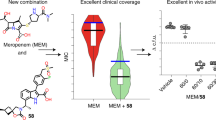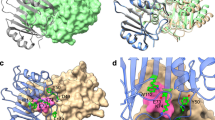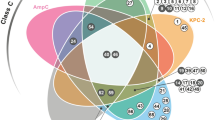Abstract
The use of β-lactam antibiotics is compromised by resistance, which is provided by β-lactamases belonging to both metallo (MBL)- and serine (SBL)-β-lactamase subfamilies. The rhodanines are one of very few compound classes that inhibit penicillin-binding proteins (PBPs), SBLs and, as recently reported, MBLs. Here, we describe crystallographic analyses of the mechanism of inhibition of the clinically relevant VIM-2 MBL by a rhodanine, which reveal that the rhodanine ring undergoes hydrolysis to give a thioenolate. The thioenolate is found to bind via di-zinc chelation, mimicking the binding of intermediates in β-lactam hydrolysis. Crystallization of VIM-2 in the presence of the intact rhodanine led to observation of a ternary complex of MBL, a thioenolate fragment and rhodanine. The crystallographic observations are supported by kinetic and biophysical studies, including 19F NMR analyses, which reveal the rhodanine-derived thioenolate to be a potent broad-spectrum MBL inhibitor and a lead structure for the development of new types of clinically useful MBL inhibitors.
This is a preview of subscription content, access via your institution
Access options
Subscribe to this journal
Receive 12 print issues and online access
$259.00 per year
only $21.58 per issue
Buy this article
- Purchase on Springer Link
- Instant access to full article PDF
Prices may be subject to local taxes which are calculated during checkout



Similar content being viewed by others
References
Butler, M. S., Blaskovich, M. A. & Cooper, M. A. Antibiotics in the clinical pipeline in 2013. J. Antibiot. (Tokyo) 66, 571–591 (2013).
Bush, K. & Jacoby, G. A. Updated functional classification of β-lactamases. Antimicrob. Agents Chemother. 54, 969–976 (2010).
Mattei, P. J., Neves, D. & Dessen, A. Bridging cell wall biosynthesis and bacterial morphogenesis. Curr. Opin. Struct. Biol. 20, 749–575 (2010).
Walsh, T. R., Toleman, M. A., Poirel, L. & Nordmann, P. Metallo-β-lactamases: the quiet before the storm? Clin. Microbiol. Rev. 18, 306–325 (2005).
Cornaglia, G., Giamarellou, H. & Rossolini, G. M. Metallo-β-lactamases: a last frontier for β-lactams? Lancet Infect. Dis. 11, 381–393 (2011).
Page, M. I. & Badarau, A. The mechanisms of catalysis by metallo β-lactamases. Bioinorg. Chem. Appl. 2008, 576297 (2008).
Ehmann, D. E. et al. Kinetics of avibactam inhibition against class A, C, and D β-lactamases. J. Biol. Chem. 288, 27960–27971 (2013).
Bebrone, C. et al. Current challenges in antimicrobial chemotherapy: focus on β-lactamase inhibition. Drugs 70, 651–679 (2010).
King A. M. et al. Aspergillomarasmine A overcomes metallo-β-lactamase antibiotic resistance. Nature 510, 503–506 (2014).
Crowder, M. W., Spencer, J. & Vila, A. J. Metallo-β-lactamases: novel weaponry for antibiotic resistance in bacteria. Acc. Chem. Res. 39, 721–728 (2006).
Bush, K. Proliferation and significance of clinically relevant β-lactamases. Ann. NY Acad. Sci. 1277, 84–90 (2013).
Grant, E. B. et al. The synthesis and SAR of rhodanines as novel class C β-lactamase inhibitors. Bioorg. Med. Chem. Lett. 10, 2179–2182 (2000).
Zervosen, A. et al. Interactions between penicillin-binding proteins (PBPs) and two novel classes of PBP inhibitors, arylalkylidene rhodanines and arylalkylidene iminothiazolidin-4-ones. Antimicrob. Agents Chemother. 48, 961–969 (2004).
Zervosen, A., Sauvage, E., Frère, J. M., Charlier, P. & Luxen, A. Development of new drugs for an old target—the penicillin binding proteins. Molecules 17, 12478–12505 (2012).
Spicer, T. et al. Probe Reports from the NIH Molecular Libraries Program (US National Center for Biotechnology Information, 2010).
McCoy, A. J. et al. Phaser crystallographic software. J. Appl. Crystallogr. 40, 658–674 (2007).
Wachino, J. et al. Structural insights into the subclass B3 metallo-β-lactamase SMB-1 and the mode of inhibition by the common metallo-β-lactamase inhibitor mercaptoacetate. Antimicrob. Agents Chemother. 57, 101–109 (2013).
Karsisiotis, A. I., Damblon, C. F. & Roberts, G. C. Solution structures of the Bacillus cereus metallo-β-lactamase BcII and its complex with the broad spectrum inhibitor R-thiomandelic acid. Biochem J. 456, 397–407 (2013).
Garcia-Saez, I. et al. The 1.5-Å structure of Chryseobacterium meningosepticum zinc β-lactamase in complex with the inhibitor, D-captopril. J. Biol. Chem. 278, 23868–23873 (2003).
Tsang, W. Y. et al. The inhibition of metallo-β-lactamase by thioxo-cephalosporin derivatives. Bioorg. Med. Chem. Lett. 14, 1737–1739 (2004).
Izquierdo, A. & Garriga, N. Dissociation constants and reactions of 3-phenyl and 3-cyclohexyl-2-mercaptopropenoic and 3-phenyl-2-mercaptopropanoic acids. Talanta 32, 669–674 (1985).
King, D. T., Worrall, L. J., Gruninger, R. & Strynadka, N. C. J. New Delhi metallo-β-lactamase: structural insights into β-lactam recognition and inhibition. J. Am. Chem. Soc. 134, 11362–11365 (2012).
Fast, W. & Sutton, L. D. Metallo-β-lactamase: inhibitors and reporter substrates. Biochim. Biophys. Acta. 1834, 1648–1659 (2013).
van Berkel, S. S. et al. Assay platform for clinically relevant metallo-β-lactamases. J. Med. Chem. 56, 6945–6953 (2013).
Siemann, S., Clarke, A. J., Viswanatha, T. & Dmitrienko, G. I. Thiols as classical and slow-binding inhibitors of IMP-1 and other binuclear metallo-β-lactamases. Biochemistry 42, 1673–1683 (2003).
Makena, A. et al. Chromophore-linked substrate (CLS405): probing metallo-β-lactamase activity and inhibition. ChemMedChem 8, 1923–1929 (2013).
Chen, H., Viel, S., Ziarelli, F. & Peng, L. 19F NMR: a valuable tool for studying biological events. Chem. Soc. Rev. 42, 7971–7982 (2013).
Rydzik, A. M. et al. Monitoring conformational changes in the NDM-1 metallo-β-lactamase by 19F NMR spectroscopy. Angew. Chem. Int. Ed. 53, 3129–3133 (2014).
Nordmann, P., Naas, T. & Poirel, L. Global spread of carbapenemase-producing Enterobacteriaceae. Emerg. Infect. Dis. 17, 1791–1798 (2011).
Zhanel, G. G. et al. Ceftazidime-avibactam: a novel cephalosporin/β-lactamase inhibitor combination. Drugs 73, 159–177 (2013).
Furdas, S. D., Shekfeh, S., Kannan, S., Sippl, W. & Jung, M. Rhodanine carboxylic acids as novel inhibitors of histone acetyltransferases. MedChemComm 3, 305–311 (2012).
Tomasic, T. & Peterlin Masic, L. Rhodanine as a scaffold in drug discovery: a critical review of its biological activities and mechanisms of target modulation. Expert Opin. Drug. Discov. 7, 549–560 (2012).
Mendgen, T., Steuer, C. & Klein, C. D. Privileged scaffolds or promiscuous binders: a comparative study on rhodanines and related heterocycles in medicinal chemistry. J. Med. Chem. 55, 743–753 (2012).
Welsch, M. E., Snyder, S. A. & Stockwell, B. R. Privileged scaffolds for library design and drug discovery. Curr. Opin. Chem. Biol. 14, 347–361 (2010).
Tomasic, T. & Masic, L. P. Rhodanine as a privileged scaffold in drug discovery. Curr. Med. Chem. 16, 1596–1629 (2009).
Acknowledgements
The authors acknowledge support from a Medical Research Council (MRC)/Canadian grant G1100135 and the Biotechnology and Biological Sciences Research Council (BBSRC; J.B. and C.J.S). Cancer Research UK (CRUK) is acknowledged for supporting S.S.v.B. and C.J.S. The authors acknowledge support from the Dulverton Trust (A.M.R.), the Royal Society Dorothy Hodgkin Fellowship (A.K.) and a German Academic Exchange Service (DAAD) Postdoctoral Fellowship (K-D.U.). The authors thank T. Walsh for supplying the clinically isolated strains used in this study.
Author information
Authors and Affiliations
Contributions
J.B., S.S.v.B. and C.J.S. conceived the research and designed the experiments. S.S.v.B. and K-D.U. synthesized and characterized the compounds used for the study. J.B. and I.P carried out the kinetic studies, purified the enzymes used in the biochemical studies, and crystallized the inhibitors with VIM-2 and BcII MBLs. W.S.A., J.B. and M.A.M. collected X-ray data and solved the crystal structures. A.M.R. designed and performed the NMR spectroscopy experiments with the help of J.B. and T.D.W.C. M.B.A. designed and performed the MIC experiments with the help of J.S. A.K. performed the cytotoxicity testing and helped with the design of the selectivity assays. J.B and C.J.S. wrote the first draft of the manuscript. All authors discussed the results and contributed to writing the manuscript.
Corresponding author
Ethics declarations
Competing interests
The authors declare no competing financial interests.
Supplementary information
Supplementary information
Supplementary information (PDF 1613 kb)
Rights and permissions
About this article
Cite this article
Brem, J., van Berkel, S., Aik, W. et al. Rhodanine hydrolysis leads to potent thioenolate mediated metallo-β-lactamase inhibition. Nature Chem 6, 1084–1090 (2014). https://doi.org/10.1038/nchem.2110
Received:
Accepted:
Published:
Issue Date:
DOI: https://doi.org/10.1038/nchem.2110
This article is cited by
-
Imitation of β-lactam binding enables broad-spectrum metallo-β-lactamase inhibitors
Nature Chemistry (2022)
-
Recent advances in the development of β-lactamase inhibitors
Journal of Microbiology (2020)
-
DeSiphering receptor core-induced and ligand-dependent conformational changes in arrestin via genetic encoded trimethylsilyl 1H-NMR probe
Nature Communications (2020)
-
Bismuth antimicrobial drugs serve as broad-spectrum metallo-β-lactamase inhibitors
Nature Communications (2018)
-
Brønsted acid-catalyzed aza-Mannich reaction of N-Boc aminals: access to multifunctional rhodanine/hydantoin derivatives
Research on Chemical Intermediates (2017)





